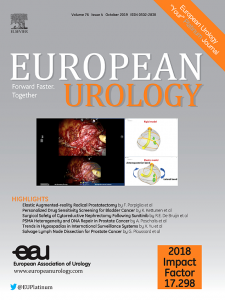雄激素抑制和前列腺放疗后的睾酮恢复(TRANSPORT):前列腺癌随机试验 Meta-Analysis of Randomized Trials in the Cancer of the Prostate (MARCAP) Consortium 的五项随机试验汇总分析。
IF 25.3
1区 医学
Q1 UROLOGY & NEPHROLOGY
引用次数: 0
摘要
背景和目的:使用促性腺激素释放激素激动剂进行雄激素剥夺治疗(ADT)后,睾酮恢复(TR)的时间差异很大。我们评估了前列腺癌患者在接受确定性放疗和 ADT 治疗后的睾酮恢复动力学以及有效阉割期对肿瘤学的影响:我们从 ADT 放射治疗随机对照试验中获得了患者的个体数据,并从 MARCAP 联合体中前瞻性地收集了连续睾酮数据。我们估算了每种ADT处方期限的非阉割TR(>1.7 nmol/l)和非性腺TR(>8.0 nmol/l)时间,并绘制了相应的提名图。我们通过多变量 Cox 回归评估了任何给定 ADT 持续时间的有效阉割期与无转移生存期 (MFS) 之间的关系。我们进行了三次样条曲线分析,以评估非线性关联:我们将五项试验中的 1444 名男性纳入分析,其中 115 人接受了 4 个月的 ADT 治疗,880 人接受了 6 个月的 ADT 治疗,353 人接受了 18 个月的 ADT 治疗,36 人接受了 28 个月的 ADT 治疗,60 人接受了 36 个月的 ADT 治疗。ADT持续时间不同,非阉割TR和非性腺TR的时间也有很大差异。较高的基线睾酮和较低的年龄与较高的 TR 可能性相关(p 结论和临床意义:TR发生时间因ADT持续时间、基线睾酮和年龄而异。有效阉割期与 MFS 之间的关系可能是非线性的,较长的有效阉割期有助于接受 6 个月 ADT 的男性。本文章由计算机程序翻译,如有差异,请以英文原文为准。
Testosterone Recovery Following Androgen Suppression and Prostate Radiotherapy (TRANSPORT): A Pooled Analysis of Five Randomized Trials from the Meta-Analysis of Randomized Trials in Cancer of the Prostate (MARCAP) Consortium
Background and objective
Time to testosterone recovery (TR) following androgen deprivation therapy (ADT) with gonadotropin-releasing hormone agonists varies widely. We evaluate TR kinetics and the oncological impact of an effective castration period in patients receiving definitive radiotherapy and ADT for prostate cancer.
Methods
We obtained individual patient data from randomized controlled trials of radiotherapy with ADT and prospectively collected serial testosterone data from the MARCAP Consortium. We estimated the times to noncastrate TR (>1.7 nmol/l) and nonhypogonadal TR (>8.0 nmol/l) were estimated for each prescribed ADT duration, and developed corresponding nomograms. The association between effective castration period and metastasis-free survival (MFS) for any given ADT duration was evaluated via multivariable Cox regression. We conducted cubic spline analyses to assess nonlinear associations.
Key findings and limitations
We included 1444 men from five trials in the analysis, of whom 115 received 4 mo, 880 received 6 mo, 353 received 18 mo, 36 received 28 mo, and 60 received 36 mo of ADT. Times to noncastrate TR and to nonhypogonadal TR varied considerably by ADT duration. Higher baseline testosterone and lower age were associated with a higher likelihood of TR (p < 0.001 for both). Effective castration period was not linearly associated with MFS for any ADT duration on Cox regression. Cubic spline analysis revealed that the optimal effective castration period for an MFS benefit was 10.6 mo for men who received 6 mo of ADT and 18 mo for men who received 18 mo of ADT.
Conclusions and clinical implications
Time to TR varies according to the ADT duration, baseline testosterone, and age. The relationship between effective castration period and MFS may be nonlinear, with a longer effective castration period being helpful for men receiving 6 mo of ADT.
求助全文
通过发布文献求助,成功后即可免费获取论文全文。
去求助
来源期刊

European urology
医学-泌尿学与肾脏学
CiteScore
43.00
自引率
2.60%
发文量
1753
审稿时长
23 days
期刊介绍:
European Urology is a peer-reviewed journal that publishes original articles and reviews on a broad spectrum of urological issues. Covering topics such as oncology, impotence, infertility, pediatrics, lithiasis and endourology, the journal also highlights recent advances in techniques, instrumentation, surgery, and pediatric urology. This comprehensive approach provides readers with an in-depth guide to international developments in urology.
 求助内容:
求助内容: 应助结果提醒方式:
应助结果提醒方式:


